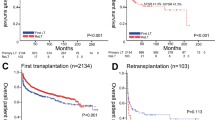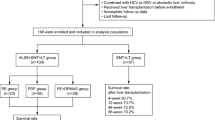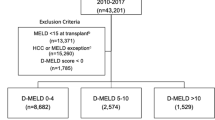Abstract
Improvements in surgical technique and the introduction of several new immunosuppressive medications mean that outcome after orthotopic liver transplantation (OLT) has improved continuously over the past 15 years. Given the increasing longevity of patients after OLT, the recognition and prevention of long-term complications after transplantation have become ever more important. With respect to graft function, physicians responsible for the everyday care of patients following transplantation should be particularly aware of the risk of late and chronic rejection episodes and of recurrence of the underlying liver disease. The major challenge of post-transplant care is, however, how best to prevent and manage the long-term adverse effects caused by the immunosuppressive medications prescribed. Screening investigations for early diagnosis of malignancy, strict control of cardiovascular risk factors, preservation of renal function, and prevention of infections are, therefore, fundamental. This Review suggests guidelines for the management of OLT recipients to improve long-term survival, overall outcome and health-related quality of life.
Key Points
-
Long-term mortality after orthotopic liver transplantation (OLT) mainly results from the recurrence of the underlying liver disease and from complications associated with the use of immunosuppressive drugs (in particular malignancy and cardiovascular disease)
-
Thorough management of the metabolic adverse effects of immunosuppressive drugs—such as diabetes mellitus, dyslipidemia, obesity, arterial hypertension and renal dysfunction—is essential for a good long-term outcome after OLT
-
The increased risk of malignancies in OLT recipients, in particular lymphomas and skin tumors, means that patients should undergo regular tumor screening
-
Reinfection with HCV and recurrent development of cirrhosis are serious and as-yet unsolved problems—treatment with pegylated interferon and ribavirin is effective but cumbersome and should be managed by an experienced physician
-
Management and prevention of recurrent HBV infection, autoimmune liver diseases, graft dysfunction and psychological problems requires an interdisciplinary approach and close collaboration among primary care physicians, gastroenterologists and the transplant center
This is a preview of subscription content, access via your institution
Access options
Subscribe to this journal
Receive 12 print issues and online access
$209.00 per year
only $17.42 per issue
Buy this article
- Purchase on Springer Link
- Instant access to full article PDF
Prices may be subject to local taxes which are calculated during checkout


Similar content being viewed by others
References
Roberts MS et al. (2004) Survival after liver transplantation in the United States: a disease-specific analysis of the UNOS database. Liver Transpl 10: 886–897
Pruthi J et al. (2001) Analysis of causes of death in liver transplant recipients who survived more than 3 years. Liver Transpl 7: 811–815
Moreno R and Berenguer M (2006) Post-liver transplantation medical complications. Ann Hepatol 5: 77–85
Muñoz SJ and Elgenaidi H (2005) Cardiovascular risk factors after liver transplantation. Liver Transpl 11 (Suppl 2): S52–S56
Rosen HR (2008) Transplantation immunology: what the clinician needs to know for immunotherapy. Gastroenterology 134: 1789–1801
Meier-Kriesche HU et al. (2006) Immunosuppression: evolution in practice and trends, 1994–2004. Am J Transplant 6: 1111–1131
Liu LU and Schiano TD (2007) Long-term care of the liver transplant recipient. Clin Liver Dis 11: 397–416
Ojo AO et al. (2003) Chronic renal failure after transplantation of a nonrenal organ. N Engl J Med 349: 931–940
Ojo AO (2007) Renal disease in recipients of nonrenal solid organ transplantation. Semin Nephrol 27: 498–507
Cicinnati VR et al. (2007) Clinical trial: switch to combined mycophenolate mofetil and minimal dose calcineurin inhibitor in stable liver transplant patients—assessment of renal and allograft function, cardiovascular risk factors and immune monitoring. Aliment Pharmacol Ther 26: 1195–1208
Schlitt HJ et al. (2001) Replacement of calcineurin inhibitors with mycophenolate mofetil in liver-transplant patients with renal dysfunction: a randomised controlled study. Lancet 357: 587–591
ClinicalTrials.gov (online September 2006) Study comparing sirolimus with cyclosporine in a calcineurin inhibitor (CNI)-free regimen in kidney transplant recipients [http://clinicaltrials.gov/ct2/show/NCT00137345?cntry1=ME%3ACY &rank=4]
ClinicalTrials.gov (online June 2008) RESCUE study—everolimus in liver transplant recipients with renal insufficiency [http://www.clinicaltrials.gov/ ct2/show/NCT00267189?term=001H2401&rank=1]
ClinicalTrials.gov (online July 2008) Preservation of renal function in liver transplant recipients with certican therapy [http://www.clinicaltrials.gov/ ct2/show/NCT00378014?term=001HDE10&rank=1]
Sheiner PA et al. (2000) Long-term medical complications in patients surviving > or = 5 years after liver transplant. Transplantation 69: 781–789
Stegall MD et al. (1997) Prednisone withdrawal late after adult liver transplantation reduces diabetes, hypertension, and hypercholesterolemia without causing graft loss. Hepatology 25: 173–177
Lucey MR et al. (2005) A comparison of tacrolimus and cyclosporine in liver transplantation: effects on renal function and cardiovascular risk status. Am J Transplant 5: 1111–1119
Chobanian AV et al. (2003) Seventh report of the Joint National Committee on Prevention, Detection, Evaluation, and Treatment of High Blood Pressure. Hypertension 42: 1206–1252
Mells G and Neuberger J (2007) Reducing the risks of cardiovascular disease in liver allograft recipients. Transplantation 83: 1141–1150
Neal DA et al. (2004) Hemodynamic effects of amlodipine, bisoprolol, and lisinopril in hypertensive patients after liver transplantation. Transplantation 77: 748–750
Neal DA and Alexander GJ (2001) Can the potential benefits of statins in general medical practice be extrapolated to liver transplantation. Liver Transpl 7: 1009–1014
Gazi IF et al. (2006) Statins and solid organ transplantation. Curr Pharm Des 12: 4771–4783
Neal DA et al. (2001) Beneficial effects of converting liver transplant recipients from cyclosporine to tacrolimus on blood pressure, serum lipids, and weight. Liver Transpl 7: 533–539
Imagawa DK et al. (1996) Hyperlipidemia after liver transplantation: natural history and treatment with the hydroxy-methylglutaryl-coenzyme A reductase inhibitor pravastatin. Transplantation 62: 934–942
Taylor PJ et al. (2004) Effect of atorvastatin on cyclosporine pharmacokinetics in liver transplant recipients. Ann Pharmacother 38: 205–208
Heisel O et al. (2004) New onset diabetes mellitus in patients receiving calcineurin inhibitors: a systematic review and meta-analysis. Am J Transplant 4: 583–595
Moon JI et al. (2006) Negative impact of new-onset diabetes mellitus on patient and graft survival after liver transplantation: long-term follow up. Transplantation 82: 1625–1628
Dumortier J et al. (2006) Conversion from tacrolimus to cyclosporine in liver transplanted patients with diabetes mellitus. Liver Transpl 12: 659–664
Wilkinson A et al. (2005) Guidelines for the treatment and management of new-onset diabetes after transplantation. Clin Transplant 19: 291–298
Villanueva G and Baldwin D (2005) Rosiglitazone therapy of posttransplant diabetes mellitus. Transplantation 80: 1402–1405
Guichelaar MM et al. (2006) Bone mineral density before and after OLT: long-term follow-up and predictive factors. Liver Transpl 12: 1390–1402
Stein E et al. (2007) Post-transplantation osteoporosis. Endocrinol Metab Clin North Am 36: 937–963
Crawford BA et al. (2006) Zoledronic acid prevents bone loss after liver transplantation: a randomized, double-blind, placebo-controlled trial. Ann Intern Med 144: 239–248
Ninkovic M et al. (2000) Incidence of vertebral fractures in the first three months after orthotopic liver transplantation. Eur J Gastroenterol Hepatol 12: 931–935
Compston JE (2003) Osteoporosis after liver transplantation. Liver Transp 9: 321–330
Schneider V et al. (2006) Association of selective and conventional nonsteroidal antiinflammatory drugs with acute renal failure: a population-based, nested case-control analysis. Am J Epidemiol 164: 881–889
Fishman JA and Rubin RH (1998) Infection in organ-transplant recipients. N Engl J Med 338: 1741–1751
Sharma S et al. (2008) Biliary strictures following liver transplantation: past, present and preventive strategies. Liver Transpl 14: 759–769
Avery R and Michaels M (2008) Update on immunizations in solid organ transplant recipients: what clinicians need to know. Am J Transplant 8: 9–14
Khan S et al. (2006) Live virus immunization after orthotopic liver transplantation. Pediatr Transplant 10: 78–82
Herrero JI et al. (2005) De novo neoplasia after liver transplantation: an analysis of risk factors and influence on survival. Liver Transpl 11: 89–97
Oo YH et al. (2005) Incidence of cancers following orthotopic liver transplantation in a single center: comparison with national cancer incidence rates for England and Wales. Transplantation 80: 759–764
Penn I (1996) Posttransplantation de novo tumors in liver allograft recipients. Liver Transpl Surg 2: 52–59
Snow AL and Martinez OM (2007) Epstein-Barr virus: evasive maneuvers in the development of PTLD. Am J Transplant 7: 271–277
Opelz G and Dohler B (2004) Lymphomas after solid organ transplantation: a collaborative transplant study report. Am J Transplant 4: 222–230
Aucejo F et al. (2006) Who is at risk for post-transplant lymphoproliferative disorders (PTLD) after liver transplantation. J Hepatol 44: 19–23
Bakker NA et al. (2007) Presentation and early detection of post-transplant lymphoproliferative disorder after solid organ transplantation. Transpl Int 20: 207–218
Cullis B et al. (2006) Sirolimus-induced remission of posttransplantation lymphoproliferative disorder. Am J Kidney Dis 47: e67–e72
Majewski M et al. (2003) Immunosuppressive TOR kinase inhibitor everolimus (RAD) suppresses growth of cells derived from posttransplant lymphoproliferative disorder at allograft-protecting doses. Transplantation 75: 1710–1717
Frey NV and Tsai DE (2007) The management of posttransplant lymphoproliferative disorder. Med Oncol 24: 125–136
American Cancer Society (online 5 March 2008) American Cancer Society guidelines for the early detection of cancer. [http://www.cancer.org/docroot/ ped/content/ped_2_3x_acs_cancer_detection_guidelines_36.asp]
Duvoux C et al. (1999) Increased incidence of oropharyngeal squamous cell carcinomas after liver transplantation for alcoholic cirrhosis. Transplantation 67: 418–421
Presser SJ et al. (2007) De novo esophageal neoplasia after liver transplantation. Liver Transpl 13: 443–450
Knight SR et al. (2007) Role of transplantation in the management of hepatic malignancy. Br J Surg 94: 1319–1330
Mazzaferro V et al. (1996) Liver transplantation for the treatment of small hepatocellular carcinomas in patients with cirrhosis. N Engl J Med 334: 693–699
Yao FY et al. (2002) Liver transplantation for hepatocellular carcinoma: comparison of the proposed UCSF criteria with the Milan criteria and the Pittsburgh modified TNM criteria. Liver Transpl 8: 765–774
Andrassy J et al. (2005) mTOR inhibition and its effect on cancer in transplantation. Transplantation 80 (Suppl 1): S171–S174
Benten D et al. (2008) Low recurrence of preexisting extrahepatic malignancies after liver transplantation. Liver Transpl 14: 789–798
Gane EJ et al. (1996) Long-term outcome of hepatitis C infection after liver transplantation. N Engl J Med 334: 815–820
Samuel D et al. (2006) Report of the monothematic EASL conference on liver transplantation for viral hepatitis (Paris, France, January 12–14, 2006). J Hepatol 45: 127–143
Berenguer M et al. (2008) Clinical benefits of antiviral therapy in patients with recurrent hepatitis C following liver transplantation. Am J Transplant 8: 679–687
Terrault N et al. (2005) Management of the hepatitis B virus in the liver transplantation setting: a European and an American perspective. Liver Transpl 11: 716–732
Sherman M et al. (2007) Management of chronic hepatitis B: consensus guidelines. Can J Gastroenterol 21 (Suppl C): S5–S24
Seehofer D and Berg T (2005) Prevention of hepatitis B recurrence after liver transplantation. Transplantation 80 (Suppl 1): S120–S124
Roche B and Samuel D (2005) Treatment of hepatitis B and C after liver transplantation. Part 1: hepatitis B. Transpl Int 17: 746–758
Rosenau J et al. (2007) Failure of hepatitis B vaccination with conventional HBsAg vaccine in patients with continuous HBIG prophylaxis after liver transplantation. Liver Transpl 13: 367–373
Starkel P et al. (2005) Response to an experimental HBV vaccine permits withdrawal of HBIg prophylaxis in fulminant and selected chronic HBV-infected liver graft recipients. Liver Transpl 11: 1228–1234
European Liver Transplant Registry [http://www.eltr.org]
Gautam M et al. (2006) Recurrence of autoimmune liver disease after liver transplantation: a systematic review. Liver Transpl 12: 1813–1824
Luettig B et al. (1998) The antinuclear autoantibodies Sp100 and gp210 persist after orthotopic liver transplantation in patients with primary biliary cirrhosis. J Hepatol 28: 824–828
Schreibman I and Regev A (2006) Recurrent primary biliary cirrhosis after liver transplantation—the disease and its management. MedGenMed 8: 30
Liermann Garcia RF et al. (2001) Transplantation for primary biliary cirrhosis: retrospective analysis of 400 patients in a single center. Hepatology 33: 22–27
Bjoro K et al. (2006) Liver transplantation in primary sclerosing cholangitis. Semin Liver Dis 26: 69–79
Demetris AJ (2006) Distinguishing between recurrent primary sclerosing cholangitis and chronic rejection. Liver Transpl 12: S68–S72
Cholongitas E et al. (2008) Risk factors for recurrence of primary sclerosing cholangitis after liver transplantation. Liver Transpl 14: 138–143
Schramm C et al. (2008) Long term outcome of patients transplanted for autoimmune hepatitis—analysis of the European liver transplant registry [abstract #102]. J Hepatol 48: S47
Gonzalez-Koch A et al. (2001) Recurrent autoimmune hepatitis after orthotopic liver transplantation. Liver Transpl 7: 302–310
Ratziu V et al. (1999) Long-term follow-up after liver transplantation for autoimmune hepatitis: evidence of recurrence of primary disease. J Hepatol 30: 131–141
Molmenti EP et al. (2002) Incidence and recurrence of autoimmune/alloimmune hepatitis in liver transplant recipients. Liver Transpl 8: 519–526
Duclos-Vallee JC et al. (2003) A 10 year follow up study of patients transplanted for autoimmune hepatitis: histological recurrence precedes clinical and biochemical recurrence. Gut 52: 893–897
Kerkar N et al. (2005) Rapamycin successfully treats post-transplant autoimmune hepatitis. Am J Transplant 5: 1085–1089
Demetris A et al. (2000) Update of the International Banff Schema for Liver Allograft Rejection: working recommendations for the histopathologic staging and reporting of chronic rejection, an international panel. Hepatology 31: 792–799
Gaglio P and Brown R (2006) Post liver transplantation management and complications. In Zakim and Boyer's Hepatology: a Textbook of Liver Disease, edn 5, 961–974 (Eds Boyer TD. et al.) Philadelphia: Saunders
Uemura T et al. (2008) Late acute rejection after liver transplantation impacts patient survival. Clin Transplant 22: 316–323
Kashyap R et al. (2001) Causes of retransplantation after primary liver transplantation in 4,000 consecutive patients: 2 to 19 years follow-up. Transplant Proc 33: 1486–1487
Neuberger J (1999) Incidence, timing, and risk factors for acute and chronic rejection. Liver Transpl Surg 5 (Suppl 1): S30–S36
Pfitzmann R et al. (2008) Long-term results after liver transplantation. Transpl Int 21: 234–246
Yazumi S and Chiba T (2005) Biliary complications after a right-lobe living donor liver transplantation. J Gastroenterol 40: 861–865
Lee HW et al. (2007) Classification and prognosis of intrahepatic biliary stricture after liver transplantation. Liver Transpl 13: 1736–1742
Fusai G et al. (2006) Incidence and risk factors for the development of prolonged and severe intrahepatic cholestasis after liver transplantation. Liver Transpl 12: 1626–1633
Roumilhac D et al. (2003) Long-term results of percutaneous management for anastomotic biliary stricture after orthotopic liver transplantation. Liver Transpl 9: 394–400
Buis CI et al. (2006) Causes and consequences of ischemic-type biliary lesions after liver transplantation. J Hepatobiliary Pancreat Surg 13: 517–524
Millonig G et al. (2006) Bactobilia after liver transplantation: frequency and antibiotic susceptibility. Liver Transpl 12: 747–753
Paumgartner G and Beuers U (2002) Ursodeoxycholic acid in cholestatic liver disease: mechanisms of action and therapeutic use revisited. Hepatology 36: 525–531
Silva MA et al. (2006) Hepatic artery thrombosis following orthotopic liver transplantation: a 10-year experience from a single centre in the United Kingdom. Liver Transpl 12: 146–151
Valente JF et al. (1996) Late hepatic artery thrombosis in liver allograft recipients is associated with intrahepatic biliary necrosis. Transplantation 61: 61–65
Bhattacharjya S et al. (2001) Delayed hepatic artery thrombosis in adult orthotopic liver transplantation—a 12-year experience. Transplantation 71: 1592–1596
Rabkin JM et al. (2001) Late mortality after orthotopic liver transplantation. Am J Surg 181: 475–479
Vignali C et al. (2004) Role of interventional radiology in the management of vascular complications after liver transplantation. Transplant Proc 36: 552–554
Abbasoglu O et al. (1997) Hepatic artery stenosis after liver transplantation—incidence, presentation, treatment, and long term outcome. Transplantation 63: 250–255
Dew MA et al. (1997) Does transplantation produce quality of life benefits? A quantitative analysis of the literature. Transplantation 64: 1261–1273
Tome S et al. (2008) Quality of life after liver transplantation: a systematic review. J Hepatol 48: 567–577
Pinson CW et al. (2000) Health-related quality of life after different types of solid organ transplantation. Ann Surg 232: 597–607
Rothenhausler HB et al. (2002) Psychiatric and psychosocial outcome of orthotopic liver transplantation. Psychother Psychosom 71: 285–297
Singh N et al. (1999) Quality of life, functional status, and depression in male liver transplant recipients with recurrent viral hepatitis C. Transplantation 67: 69–72
Cuadrado A et al. (2005) Alcohol recidivism impairs long-term patient survival after orthotopic liver transplantation for alcoholic liver disease. Liver Transpl 11: 420–426
Dew MA et al. (2008) Meta-analysis of risk for relapse to substance use after transplantation of the liver or other solid organs. Liver Transpl 14: 159–172
Adams PC et al. (1995) Employment after liver transplantation. Hepatology 21: 140–144
Kirchner GI et al. (2006) Outcome and quality of life in patients with polycystic liver disease after liver or combined liver-kidney transplantation. Liver Transpl 12: 1268–1277
Newton SE (1999) Recidivism and return to work posttransplant: recipients with substance abuse histories. J. Subst Abuse Treat 17: 103–108
Acknowledgements
Désirée Lie, University of California, Irvine, CA, is the author of and is solely responsible for the content of the learning objectives, questions and answers of the Medscape-accredited continuing medical education activity associated with this article.
Author information
Authors and Affiliations
Corresponding author
Ethics declarations
Competing interests
The authors declare no competing financial interests.
Rights and permissions
About this article
Cite this article
Benten, D., Staufer, K. & Sterneck, M. Orthotopic liver transplantation and what to do during follow-up: recommendations for the practitioner. Nat Rev Gastroenterol Hepatol 6, 23–36 (2009). https://doi.org/10.1038/ncpgasthep1312
Received:
Accepted:
Published:
Issue Date:
DOI: https://doi.org/10.1038/ncpgasthep1312
This article is cited by
-
Lebertransplantation in der Schweiz 2020
Schweizer Gastroenterologie (2020)
-
Evolution and Trends in Reconstructive Facial Surgery: An Update
Journal of Maxillofacial and Oral Surgery (2012)



